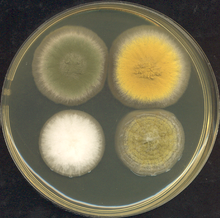- Medicinal molds
-
Medicinal molds are molds which were the original source of certain medicines. The most important contribution to medicine by medicinal molds include the first statins and the discovery of penicillin.
Contents
Statins
Akira Endo first discovered statins, also known as HMG-CoA reductase inhibitors, by researching fermentation of the mold Penicillium citrinum. The first statin, he discovered was mevastatin.
In 1978, Merck Research Laboratories discovered the next statin drug by researching a fermentation product of Aspergillus terreus. Their discovery was later named lovastatin.[1] Pravastatin was later found researching Aspergillus terreus.[1] Using a product of Aspergillus terreus, researchers synthesized simvastatin.
Red yeast rice is made from cultivating Monascus purpureus on rice. Red yeast rice is known to contain the statin lovastatin, which is produced by the growth of Monascus purpureus.[2]
Zaragozic acids
Zaragozic acids like statins, inhibit cholesterol synthesis.[3] Zaragozic acids D and D2 have been isolated from Amauroascus niger.[4]
Antibiotics
Penicillin a beta-lactam antibiotic, was discovered being produced by the mold Penicillium notatum. Cephalosporins are a class of antibiotics discovered in Acremonium molds.[2]
Antifungal
Griseofulvin is an antifungal discovered in Penicillium griseofulvum.
Immunosuppressants
Ciclosporin, an immunosuppressant was discovered researching Tolypocladium inflatum. Mycophenolic acid is derived from Penicillium stoloniferum.
Potential as a biological source of pharmaceuticals
Many fungi that associate with Taxus, are capable of producing paclitaxel, one of the most important anticancer drugs known. Researchers noted Fusarium solani is capable of producing camptothecin, a potent cancer inhibitor. Researchers found Aspergillus fumigatus Fresenius is capable of producing the anticancer pro-drug deoxypodophyllotoxin. Researchers have found a fungus capable of producing hypericin, and another capable of producing vinblastine.
See also
- Ant-fungus mutualism
- Aspergillus oryzae (kōji) fungus used in the production of soy sauce, miso, and sake.
- Kombucha (红茶菌 "tea fungus") a beverage made from yeast and bacteria.
- Medicinal mushrooms
- Mycorrhiza medicinal fungi of the plant kingdom.
- Penicillium camemberti
- Penicillium roqueforti
- Saccharomyces boulardii a medicinal yeast first isolated from lychee and mangosteen.
- Yeast-based foods and supplements - Nutritional yeast, EpiCor, Vegemite, Guinness Yeast Extract, Marmite.
References
- ^ Endo, Akira (2004). "The origin of the statins". International Congress Series 1262: 3–8. doi:10.1016/j.ics.2003.12.099. http://www.sciencedirect.com/science?_ob=ArticleURL&_udi=B7581-4C9R7K1-2&_user=5915660&_origUdi=B6X14-4DPSB32-P&_fmt=high&_coverDate=05%2F31%2F2004&_rdoc=1&_orig=article&_acct=C000068853&_version=1&_urlVersion=0&_userid=5915660&md5=b7da267cdd480f83626db6ca9959aed4.
- ^ Liu J, Zhang J, Shi Y, Grimsgaard S, Alraek T, Fønnebø V (2006). "Chinese red yeast rice (Monascus purpureus) for primary hyperlipidemia: a meta-analysis of randomized controlled trials.". Chin Med 1: 4. doi:10.1186/1749-8546-1-4. PMC 1761143. PMID 17302963. http://www.ncbi.nlm.nih.gov/entrez/eutils/elink.fcgi?dbfrom=pubmed&tool=sumsearch.org/cite&retmode=ref&cmd=prlinks&id=17302963.
- ^ Bergstrom JD, Dufresne C, Bills GF, Nallin-Omstead M, Byrne K (1995). "Discovery, biosynthesis, and mechanism of action of the zaragozic acids: potent inhibitors of squalene synthase.". Annu Rev Microbiol 49: 607–39. doi:10.1146/annurev.mi.49.100195.003135. PMID 8561474.
- ^ Dufresne C, Wilson KE, Singh SB, Zink DL, Bergstrom JD, Rew D et al. (1993). "Zaragozic acids D and D2: potent inhibitors of squalene synthase and of Ras farnesyl-protein transferase.". J Nat Prod 56 (11): 1923–9. doi:10.1021/np50101a009. PMID 8289063.
Categories:- Medicinal fungi
Wikimedia Foundation. 2010.

